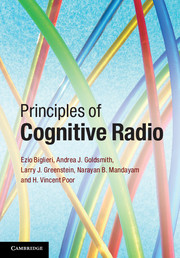2 - Capacity of cognitive radio networks
Published online by Cambridge University Press: 05 December 2012
Summary
Introduction
This chapter develops the fundamental capacity limits and associated transmission techniques for different cognitive radio network paradigms. These limits are based on the premise that the cognitive radios of secondary users are intelligent wireless communication devices that exploit side information about their environment to improve spectrum utilization. This side information typically consists of knowledge about the activity, channels, encoding strategies, and/or transmitted data sequences of the primary users with which the secondary users share the spectrum. Based on the nature of the available side information as well as regulatory constraints on spectrum usage, cognitive radio systems seek to underlay, overlay, or interweave the secondary users' signals with the transmissions of primary users. This chapter develops the fundamental capacity limits for all three cognitive radio paradigms. These capacity limits provide guidelines for the spectral efficiency possible in cognitive radio networks, as well as practical design ideas to optimize performance of such networks.
While the general definition of cognitive radio was provided in Chapter 1, we now interpret that definition in a mathematically precise manner that can be used in the development of cognitive radio capacity limits. Specifically, in the mathematical terminology of information theory, it is the availability and utilization of network side information that defines a cognitive radio, which we formalize as follows.
A cognitive radio is a wireless communication device that intelligently utilizes any available side information about the (a) activity, (b) channel conditions, (c) encoding strategies, or (d) transmitted data sequences of primary users with which it shares the spectrum.
- Type
- Chapter
- Information
- Principles of Cognitive Radio , pp. 41 - 101Publisher: Cambridge University PressPrint publication year: 2012
- 4
- Cited by



